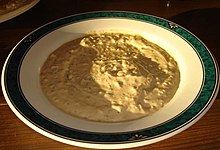Tahini
Tahina [ tˤɒˈħiːna ] ( Arabic طحينة), also tahini or tahini is a paste made from finely ground sesame seeds . It comes from Arab cuisine and is a basic ingredient in hummus (chickpea porridge). It is also served as a side dish or as a dip , mixed with lemon juice and garlic and often seasoned with sumac .
A distinction is made between peeled and unpeeled sesame tahini. Tahini made from unpeeled sesame seeds is darker, but contains more vitamins, nutrients and, at around 10 grams per 100 grams, more fiber . Often, tahini is made from a mixture of both sesame seeds. Tahini made exclusively from peeled sesame is called white tahini .
Tahini is very rich in vitamins (especially B1 , B2 and B6 ), contains a lot of magnesium , potassium , iron , copper , zinc and phosphorus and some calcium . It is also rich in protein (around 20%) and unsaturated fatty acids (both omega-3 and omega-6). It is therefore popular with vegetarians and vegans and is often offered as an alternative to spreads like peanut butter in health food stores , but also in Turkish or Arab grocery stores.
Baba Ghanoush , a dip made from grilled, pureed eggplant and tahini , is also common in the Orient . Tahina can also be used to make halva .
In Chinese cuisine , such a paste is called Zhimajiang ( Chinese 芝麻醬 / 芝麻 醤 , Pinyin Zhīmajiàng ) and in Japanese cuisine as Nerigoma ( Japanese 練 り 胡麻 / 練 り ご ま / 練 り ゴ マ , "sesame paste"), where they are often used together in dishes is used with soy sauce . In Germany such mixtures are offered under the name Goma (Japanese for sesame).
Web links
Individual evidence
- ↑ Dieter Rex: Herbs and Spices . Unipart, Remseck near Stuttgart 1994, ISBN 3-8122-3364-9 , p. 277 .

